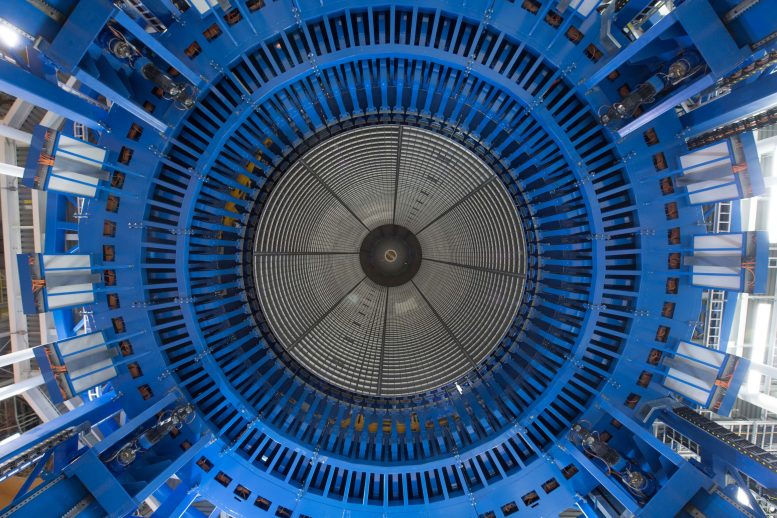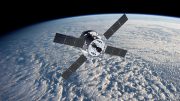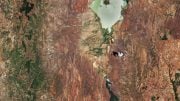This image gives us a look up inside a nearly complete fuel tank for NASA’s powerful, new rocket—the Space Launch System – that will take humans to destinations never explored by people before.
At over 300 feet (90 meters) tall and 5.75 million pounds (2.6 million kilograms) at liftoff, SLS needs plenty of fuel to leave Earth. Once a final dome is added to the liquid hydrogen rocket fuel tank, shown here, it will come in at 27.5 feet (8.4 meters) in diameter and over 130 feet (40 meters) long, making it the largest major part of the SLS core stage. The core stage forms the rocket’s backbone and has five major parts, all of which are being manufactured at NASA’s Michoud Assembly Facility in New Orleans.
Core stage tanks carry all the cryogenic liquid hydrogen and liquid oxygen combusted in four RS-25 engines to produce two million pounds of thrust. The tank holds 537,000 gallons (2 million liters) of chilled liquid hydrogen that is completely combusted in the engines in the short 8.5 minutes it takes to send the SLS and Orion crew vehicle into orbit. The blue section, shown here, is part of the world’s largest robotic weld tool in the Vehicle Assembly Center at Michoud.
Inside the tool, five barrels and one dome were welded to make the tank, shown here in silver; engineers will cap it with one more dome to complete tank welding. While the tank is smooth on the outside, the inside appears to have ridges because the cylindrical barrels that form the tank are manufactured with square patterns created by stiffening ribs machined into them to make the walls light but uniformly strong in every direction. When it is finished, a barge will carry this tank to NASA’s Marshall Space Flight Center in Huntsville, Alabama.
While this qualification tank won’t actually fly, it will be tested at Marshall in a stand that simulates launch and ascent forces. Traveling to deep space requires a large vehicle that can carry huge payloads, and SLS will have the power and payload capacity needed to carry crew and cargo needed for exploration missions to deep space, including Mars. For the first flight of the SLS rocket, the Block I configuration can lift 70 metric tons (77 tons).
The next planned upgrade of SLS, known as Block 1B, will use a more powerful exploration upper stage for more ambitious missions with a 105-metric-ton (115-ton) lift capacity. For both configurations, SLS will use the same core stage and four RS-25 engines. The Boeing Co., headquartered in Chicago, is the prime contractor for the SLS core stage, including avionics, and Aerojet Rocketdyne of Sacramento, California, is the prime contractor for the RS-25 engines.










I had an Uncle that worked for Lockheed in Texas before he retired and I talked to him at a family gathering in the late 1990’s. I’d read about the TR-3B Project Aurora in magazines describing it as an anti-gravity ship. So I asked my Uncle if he worked on Project Aurora and he said, “Yes, I do.” I asked if it is a ramjet and he said, “No.” I asked if was a conventional jet and he said, “No.” I asked if it was a chemical rocket and he said, “No.” I asked if was anti-gravity. He got very nervous suddenly and in a panic said, “I can’t talk about it!” He quickly walked away from me and avoided me for the rest of the gathering. I’ve been told not to email him. He’s blocked my email. I haven’t seen him since that gathering. Almost 10 years ago I asked an Air Force General acquaintance with high level intelligence clearance about Project Aurora saying its anti-gravity isn’t it. He replied, “Technically it’s pulsed magnetic propulsion. He said that the main problem with it is the need for a high amount of energy to fuel it.” Its time the shadow government allows the anti-gravity Project Aurora to be used by NASA.
feet?
gallons?
At least you measure weight in tons and time in minutes..